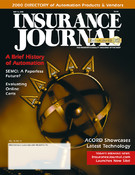Sure, independent agencies offer a choice of markets. That’s a nice benefit. But it also means you must key in customer information more than once in different formats and screens to accommodate the various companies. Add to that the agency technology system screens-and in some cases a separate rating system. After a while, I’m sure you get numb to the double and triple entry. But it’s a big waste of time.
For at least two decades agents have sought ubiquitous “single-entry, multiple company interface,” or SEMCI for personal and commercial lines.
Although the term sounds like some bad disease, SEMCI isn’t complicated. The agent-or perhaps the customer-enters the policy information or quote request one time (single-entry) into very familiar information fields. The work is transmitted real-time in ACORD standards to one and/or a number of markets (multiple company interface). Unique underwriting “edits” are transparent to the agency. So is all the other technology. Any responses, if necessary, are transmitted back just as seamlessly. It’s just easier.
When this discussion started two or three decades ago-heck, it was in the last century now-the Internet wasn’t a pervasive communications tool. If agencies had seven markets, they’d have seven computers-one for each company. History is repeating itself. The Internet is breeding a new brand of proprietary company screens. The difference is one computer reaches every market. And the graphic user interfaces are pretty slick. But it’s still double or triple work.
What happened?
• Too many players. Industry associations, companies and agency technology service providers have struggled to agree on: a) what’s required for the “good of the distribution system,” which takes more time and effort, than b) what’s good for themselves, which takes less time.
“SEMCI could realistically be accomplished in a year if the industry really wanted it,” said one industry association source. “The technological issues aren’t trivial. But the business issues are the real obstacles that have always inhibited the technological effort.”
• Companies competing on technology. “Companies are holding on to the silly assumption that there’s a competitive advantage to be had from technology infrastructure,” said Todd Youngblood, a former IVANS executive who consults on sales and technology. “The focus should be on doing things that are based on the truly unique capabilities of the firm. Foot-dragging regarding SEMCI, which is firmly planted in the ‘technology infrastructure’ category, is downright dumb.”
“The primary problem is that retail insurance carriers believe that proprietary data structures, rates, rules and the associated technologies needed to support them are a competitive advantage,” said another industry consultant. “Thus, the effort to standardize and streamline the exchange of data, which could facilitate the potential for agents and brokers to easily shop their products, are viewed as anti-competitive. Unfortunately, [the companies’] refusal to expose their systems to full integration in order to thwart this perceived threat also increases the costs for everyone to move the data for all processes among the participants-clients, brokers, carriers and reinsurers.”
• Agency technology system providers fighting for business. Each technology vendor has a proprietary format for upload and download. The carriers have programming costs to deal with each. Moreover, as with all technology, the vendor systems are evolving, which means continual reprogramming.
And the vendors are scrambling to update older offerings with today’s technology. For example, they are threatened by Internet real-time communications and outsourced agency customer databases to application service providers (ASPs).
• Agents haven’t demanded change, at least not loudly enough. What’s true today, as it was back in the last century, is that if enough agents understood the SEMCI concept and truly demanded it, they’d have it.
Having said all that, SEMCI is closer now than it’s ever been, for two reasons. The first is new technological developments. The Internet brings new technology, tools and a globally standardized way of communications between people and computers. (That would be TCP/IP and HTTP for the network standard(s); HTML and DHTML for Web pages among people; and XML for data and context among computer applications.)
“If the technology is used properly and in an industry-standard way, we would get SEMCI in a faster and more globally ubiquitous manner,” said Kevin Kelly, worldwide insurance industry manager at Microsoft.
And with the Internet and XML standards, the concept of SEMCI is happening whether the industry wants it or not, argues agency technology consultant Steve Anderson. “Customer expectations are driving what we have to provide to remain viable in the next several years.
“We could share data tomorrow if we really wanted to,” Anderson added, cautioning: “It doesn’t matter anymore whether we want to. If we don’t do it someone else outside the industry will.”
The second reason SEMCI is closer is grassroots involvement by agents. “The companies have spent a good deal of money and invested thousand of staff hours in working with ACORD to establish the SEMCI standards,” said Tacoma, Wash.-based independent agent Tom Taylor, president of the Applied Systems Client Network (ASCnet), the Applied Systems user group. “They now need to take those standards and implement them in their operations so we can move forward together and benefit from the tremendous investment in automation that both agents and companies made.”
ASCnet member Brian Bartosh, a Michigan agent, is overseeing a series of “Interface 2000 Working Groups” designed to bring together regional and national company executives with independent agents in a grassroots effort to promote SEMCI.
Bartosh said the meetings aren’t a presentation per se. “This isn’t some PowerPoint demonstration; this is a true working group. At the end of the meetings we have agents and companies sitting down with plans and an implementation schedule. I am hoping to have many success stories by the end of the year.” One such meeting will be held at the ACORD Technology Conference this month in Orlando.
Taylor added, “The fact that a number of companies have successfully implemented SEMCI is proof positive that it is possible and do-able. All we need is the commitment of the companies…to work with those vendors and agents who are ready, willing and able to interface on the basis of ACORD standards. Just do it.”
Taylor and the top agent leadership of most other technology system users recently met to assemble a battle plan on SEMCI. The Agency Management System Users’ Group Leadership Summit was convened by IIAA’s Agents Council for Technology, or ACT.
Collectively, these groups represent more than 90 percent of agency management systems in use. In a statement, the group said: “Proprietary implementations of technology have a negative impact on independent agents…the Internet should serve to facilitate common ways of doing business-not provide an opportunity for circumventing a SEMCI approach.”
The ACT group “also agreed that agents must support the new technology exemplified in ACORD’s XML standards and dissuade carriers from creating their own proprietary systems. Banding together to achieve this collective goal will allow us to use new technology to make the Independent Agency System the distribution system of choice.”
At the ACORD Conference, ACT will launch a campaign called, “Elect SEMCI in November.” ACT officials promise a grassroots, full-court press on agents, companies and vendor systems.
“Elect SEMCI in November” is a good slogan. Agents will have to work hard to be sure it doesn’t become another moniker such as the classic “Paper Free in ’83.” Or was that ’73?
Peter van Aartrijk, a 20-year insurance industry veteran, owns a communications firm specializing in the independent agent distribution.
Was this article valuable?
Here are more articles you may enjoy.


 CEO Sentenced in Miami to 15 Years in One of the Largest Health Care Fraud Cases
CEO Sentenced in Miami to 15 Years in One of the Largest Health Care Fraud Cases  Judge Green Lights New York’s Driver’s License Law, Rejecting Trump Challenge
Judge Green Lights New York’s Driver’s License Law, Rejecting Trump Challenge  Cloudy Future for Bourbon Has Jim Beam Closing Distillery for a Year
Cloudy Future for Bourbon Has Jim Beam Closing Distillery for a Year  Grand Jury Declines to Indict Man in Fatal Shooting at Kentucky State University
Grand Jury Declines to Indict Man in Fatal Shooting at Kentucky State University 



